Discovering New Zealand: Nature and Culture Uncovered
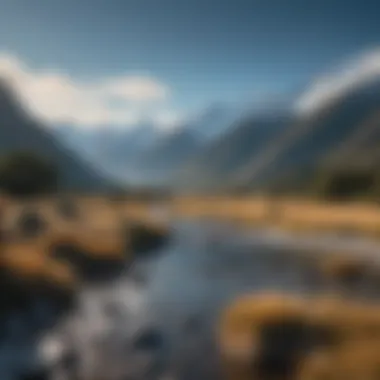
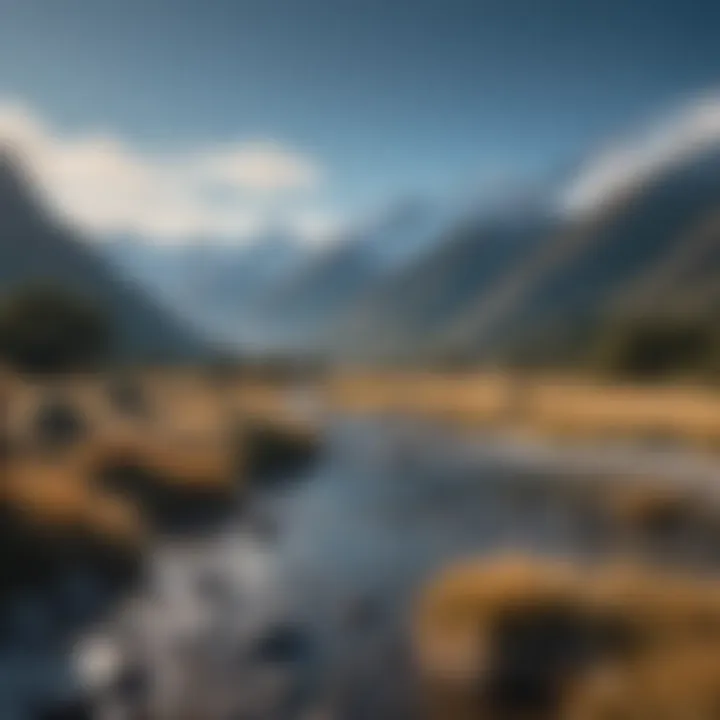
Nature Topic Overview
New Zealand, often called the land of the long white cloud, is a treasure trove of natural marvels. With a blend of lush green hills, pristine beaches, and towering mountains, it boasts a unique landscape that beckons explorers from all corners of the globe. This island nation is not only a feast for the eyes, but it also serves as a delicate ecosystem home to diverse flora and fauna, many of which are found nowhere else on the planet.
A Unique Landscape
From the geothermal wonders of Rotorua to the surreal fjords of Milford Sound, every part of New Zealand offers something distinct. The North Island is where you’ll find vibrant cities like Auckland and Wellington alongside stunning natural attractions like the Coromandel Peninsula. Meanwhile, the South Island features mountains and lakes that seem like they belong on a postcard.
Rich Biodiversity
New Zealand is considered a hotspot for biodiversity. It houses various species, some incredibly rare, such as the kiwi bird. This flightless bird, a national symbol, is nocturnal and seldom seen during the day. Understanding and protecting these unique creatures is vital for preserving New Zealand’s ecosystem.
"New Zealand's landscapes are not just beautiful; they also tell the story of the environment and its inhabitants."
Fun Facts and Trivia
- Did you know that New Zealand has no snakes? That's right! The climate and terrain simply don't support them.
- The tallest mountain in New Zealand is Aoraki/Mount Cook, standing proudly at 3,724 meters (12,218 feet).
- New Zealand is home to more than 40 million sheep! That's about six sheep for every person.
Visuals and Interactive Elements
To make learning more fascinating, children can look at maps that highlight New Zealand's various national parks. Colorful images of landscapes, animals, and Maori art will keep young readers engaged. Incorporating activities like drawing a kiwi or crafting a simple model of a fjord can enhance their experience.
Wildlife Explorations
New Zealand is a paradise for animal lovers. The country features a variety of species that thrive in its unique habitats, including:
- Kiwi - This iconic bird is known for its long beak and brown, fuzzy feathers.
- Takahe - Once thought to be extinct, this colorful bird now flourishes in the wild.
- Kea - An intelligent parrot known for its playful nature.
- Māori cultural symbols - The Tūī bird, famous for its melodious calls, plays a significant role in Māori folklore.
Did You Know?
Many animals and plants have adapted uniquely to New Zealand's environment, allowing them to survive and thrive in this isolated setting. For instance, the Takaka region is home to ancient forests where giant ferns and towering kauri trees create a magical atmosphere.
Environmental Awareness
As we enjoy all the wonders New Zealand has to offer, it’s crucial to think about conservation. Here are a few reasons why protecting New Zealand’s environment matters:
- Biodiversity Protection: Each species plays a role in maintaining ecological balance. Losing one could create a ripple effect.
- Cultural Significance: The land and its resources are vital to Maori culture. Understanding this connection is key to appreciating New Zealand’s beauty.
Tips for Young Conservationists
Kids can do their part too! Here are a few simple ways:
- Reduce, Reuse, Recycle: Make it a habit to sort waste at home.
- Nature Cleanup Days: Participate in local clean-up events in parks or beaches.
- Nature Journal: Keep a diary of plants and animals you observe.
DIY Nature Activities
Getting creative is a fantastic way for kids to engage with nature. Here are some ideas:
Create a Nature Collage
- Collect leaves, flowers, and twigs on a walk.
- Use a large piece of paper to arrange them.
- Glue them down to create a vibrant collage.
Plant a Mini Garden
- Get some seeds, soil, and a pot.
- On a sunny day, have kids plant their seeds and watch them grow!
Explore Outdoors
- Plan family outings to local parks or botanical gardens. Let kids observe the different plants and animals.
Through these activities, kids not only learn about the magnificent landscapes of New Zealand but also cultivate a deep appreciation for nature.
Prolusion to New Zealand
New Zealand stands as a stunning example of nature’s artistry, where breathtaking landscapes and a rich cultural tapestry intertwine. This section dives into the importance of understanding New Zealand, particularly for young minds eager to explore the world around them. By learning about its unique geography, ecology, and vibrant cultures, readers can cultivate a deep sense of appreciation and respect for this remarkable country. Not only does New Zealand offer beautiful sights but it also opens doors to valuable lessons about conservation, heritage, and connection with nature.


Geographical Overview
New Zealand, made up of two main islands—the North Island and the South Island—presents an array of diverse geographical features. From towering mountains to lush green valleys, every corner reveals something special. The country is located in the southwestern Pacific Ocean, making it somewhat isolated, which contributes both to its pristine nature and endemic species.
Imagine standing on the shores where the Pacific Ocean kisses sandy beaches, then looking inland to see mighty peaks rising from the earth. The Southern Alps, for example, stretch majestically across the South Island. Mount Cook, the highest peak, reaches a height of 3,724 meters. It’s not just the heights that are impressive; the valleys carve into the mountains, creating rich habitats for various plants and animals.
New Zealand also boasts an extensive coastline, with over 15,000 kilometers of it, dotted with hidden coves and surf-friendly beaches. This geographical diversity doesn’t just create spectacular views; it also offers many outdoor activities. Exploring these landscapes can be an adventure in itself—hiking through the forests, kayaking in tranquil waters, or simply enjoying the serene beauty of the environment.
Cultural Significance
The culture of New Zealand is as colorful as its landscapes. The indigenous Maori people hold a significant place in the history and identity of the nation. Their traditions, mythology, and language are woven into the fabric of everyday life in New Zealand. Understanding this cultural significance is crucial for young readers, as it emphasizes the importance of heritage and connection to one’s roots.
Maori culture emphasizes respect for nature, a principle that resonates profoundly with the country's conservation efforts. The concept of whanaungatanga, or kinship, reflects the ties between people and their environment. This understanding can inspire children to see themselves as part of a larger ecosystem, promoting a sense of responsibility towards protecting nature.
Immersing in Maori traditions, such as their intricate carvings and brightly woven textiles, allows individuals to appreciate craftsmanship and storytelling. It’s like opening a window to a world rich in history and profound wisdom.
Natural Landscapes
New Zealand boasts a stunning variety of natural landscapes, each more breathtaking than the last. This section highlights the significance of these diverse terrains not just as aesthetic marvels, but also as essential ecosystems supporting various forms of life. The natural landscapes of New Zealand are like pages from a fantastical storybook, brimming with adventure and wonder. They serve as both habitat and playground, making it critical for young explorers and their guardians to understand and appreciate these environments.
Mountains and Valleys
The towering mountains and lush valleys of New Zealand are majestic. The Southern Alps, for instance, loom over the South Island like ancient sentinels. The snow-capped peaks provide a stark contrast to the verdant valleys below. One can hike through these valleys on trails like the famous Routeburn Track, where the scenery feels almost otherworldly.
But mountains are not just beautiful to look at; they also play a vital role in the ecosystem. Their elevation creates specific climates, impacting the flora and fauna inhabiting these regions. You'll find unique plant species, like the resilient mountain daisy, which flourishes in harsh conditions. Understanding how these ecosystems work can inspire a sense of stewardship in younger generations.
“Mountains are the beginning and the end of all natural scenery.” - John Ruskin
Coastlines and Beaches
The coastlines of New Zealand are as diverse as they are captivating. From the shimmering beaches of the Coromandel Peninsula to the rugged cliffs of the Fiordland National Park, each stretch of coast offers unique experiences. Children can play in the golden sands of Piha Beach, while parents surf the exhilarating waves. The rock formations and tide pools introduce a whole new world of marine life waiting to be explored.
Coastlines serve as crucial habitats for countless species, including seabirds and seals. Understanding the significance of these areas fosters a sense of responsibility to protect them. Besides, young nature enthusiasts will find that exploring coastlines can be a treasure hunt full of shells, driftwood, and fascinating creatures.
Lakes and Rivers
Lakes and rivers crisscross New Zealand, offering breathtaking views and rich ecosystems. Take Lake Taupo, the largest lake in New Zealand, which is fed by the mighty Waikato River—great spots for fishing, boating, and simply soaking in the tranquility of nature. These waterways not only provide recreational activities but also support diverse aquatic life.
Rivers like the Clutha and the Buller are vital arteries that nourish the land. They allow for significant biodiversity, playing a crucial role in the life cycles of countless species. Children who learn about the interconnectedness of these waterways are more likely to cherish and safeguard them for future generations.
Unique Ecosystems
New Zealand's unique ecosystems serve as the heart of its environmental richness. These ecosystems are not just landscapes; they are biological treasure chests filled with species and habitats that thrive nowhere else on earth. They offer vital benefits, from regulating the climate to providing resources such as food and clean water. Recognizing the importance of these systems can lead to a greater understanding and appreciation that resonates deeply with both local and global communities.
The South Island Rainforest
The South Island's rainforest is like stepping into another world. Lush, green, and teeming with life, it hosts towering trees, vibrant ferns, and a cacophony of bird songs. It’s a perfect example of a biodiversity hotspot. The forest plays a crucial role in absorbing carbon dioxide and releasing oxygen. Not to mention, these rainforests are home to unique species, many of which are endangered.
Among the most notable residents of this ecosystem are the Kiwi birds. These nocturnal and flightless marvels are symbol of New Zealand. Their unique adaptations and reliance on this habitat emphasize the interconnectedness of all lives present in the rainforest.
"In New Zealand’s forest, a tree may fall, but nature teaches resilience—the earth replenishes and life circles back."
Alpine Regions
The alpine regions of New Zealand tell a different story. As you ascend the mountains, the landscape shifts dramatically. Here, it’s not all greenery; instead, you find rugged terrain and an astonishing array of flora and fauna adapted to the harsh conditions. Extreme weather means only the toughest survive, leading to a unique ecosystem where biodiversity thrives against the odds.
Unique species such as the Takahe, a large flightless bird once thought extinct, find refuge in these high-altitude environments. The alpine zone also significantly impacts New Zealand's water systems, acting as crucial watersheds. Even as nature appears harsh, it offers critical resources, teaching us about strength and adaptability.
Marine Ecosystems
Diving beneath the waves surrounding New Zealand unveils vibrant marine ecosystems. These underwater habitats host colorful coral reefs, kelp forests, and a myriad of fish species, contributing to the marine biodiversity for which the country is renowned. But it’s not just about the beauty; marine ecosystems play a vital role in Earth’s health. They provide food, medicine, and employment for millions, making it essential to protect them.
Several marine reserves, like the Poor Knights Islands, are prime locations for snorkeling and diving. They showcase jaw-dropping underwater art, where the dance of the fish provides a visceral reminder of nature’s splendor. Furthermore, the delicate balance maintained within these ecosystems illustrates how interconnected life is on our planet.
In all, the unique ecosystems of New Zealand not only shape its landscapes but also support an intricate web of life. By understanding and conserving these areas, we nurture not just the present but future generations, encouraging a deep-seated appreciation for nature.
Flora and Fauna
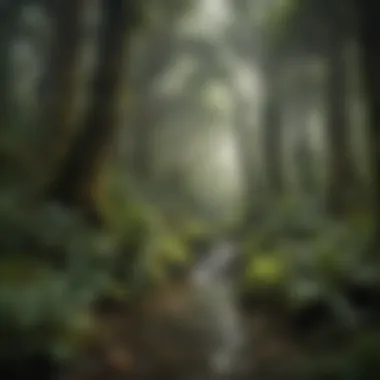
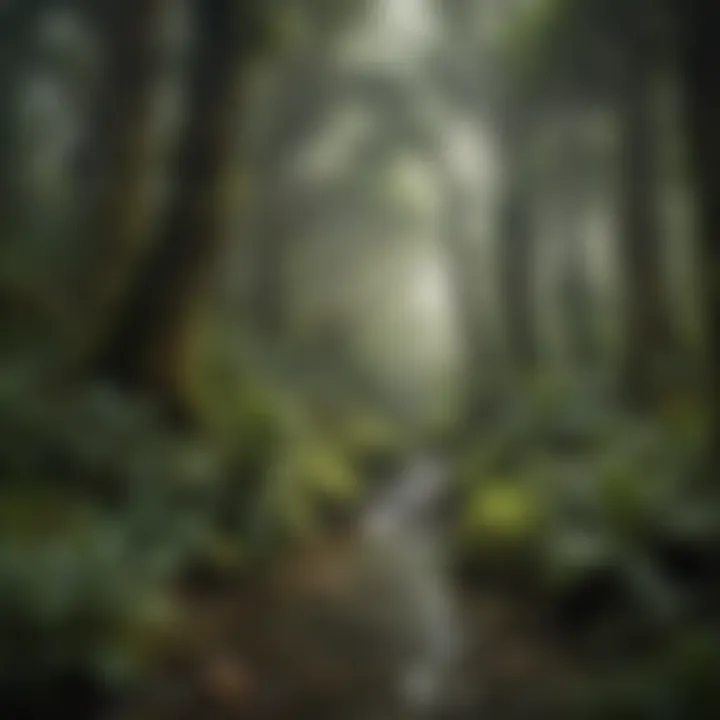
New Zealand’s flora and fauna are not just a collection of plants and animals; they are a vibrant tapestry that tells the story of the land and its environments. Understanding this unique aspect is essential as it helps us appreciate the intricate relationships that exist within ecosystems and the delicate balance of nature. The rich diversity of plant life and animal species plays a critical role in maintaining healthy ecosystems, which in turn supports human life and activities. Moreover, these natural wonders spark curiosity, encouraging young readers to learn more about conservation and the importance of protecting our environment.
Indigenous Plant Species
New Zealand is home to a multitude of indigenous plant species, many of which are found nowhere else on the planet. For instance, the kauri tree, towering and majestic, can grow to be over 50 meters high. Its thick trunk and expansive canopy offer shelter to countless creatures. The pōhutukawa, often called the New Zealand Christmas tree due to its vibrant red flowers in December, is a sight to behold along the coastline.
The presence of these plants is not just for beauty; they provide essential services. They help control soil erosion, purify the air, and create habitats for various animal species. Understanding the role these plants play gives us insight into why they should be conserved. As young readers explore gardens or forests, they may notice these species and their significant contributions to the ecosystem.
Animal Diversity
When it comes to animal diversity, New Zealand is a treasure trove. From the tiny, elusive bush wren to the remarkable kiwi, each species contributes to the ecological balance of the environment. One fascinating feature of the country’s wildlife is the numerous flightless birds, a rarity in the world. The loss of their predators allowed these birds to thrive, creating an ecosystem unlike any other.
Many animals in New Zealand are recognized for their unique characteristics. For example, the takahe, a large, colorful bird thought to be extinct but rediscovered in the 1950s, has become a symbol of conservation success. This diversity isn’t just fascinating; it also reveals the complexity and interdependence of life forms. Encouraging curiosity about local wildlife can motivate children to respect and protect these animals, acknowledging their vital roles in the ecosystem.
Unique Wildlife
New Zealand boasts some of the world’s most unique wildlife. One of the most famous residents is the kiwi, a flightless bird that has become a national icon. Kiwis are nocturnal and have a keen sense of smell, making them distinct and charming. Their round bodies and long beaks make them look quite peculiar, but they are a delightful representation of New Zealand’s unique natural history.
Another fascinating creature is the haka, an ancient ritual dance performed by the Maori people, which often imitates the behavior of wild animals. This connection between wildlife and culture demonstrates how intertwined the two are in New Zealand.
Moreover, the marine life surrounding the islands is just as mesmerizing. The Hector’s dolphin, one of the world’s smallest and rarest dolphins, can be spotted in the coastal waters. They are playful and often leap through the waves. Protecting such unique wildlife is crucial as they face threats from habitat destruction and pollution.
"In every walk with nature, one receives far more than he seeks." – John Muir
Maori Culture and Traditions
Understanding Maori culture and traditions is crucial to grasping the rich tapestry that is New Zealand. It is a cornerstone of the nation's identity, deeply woven into its history and ongoing narrative. The Maori, the indigenous people of New Zealand, have a unique worldview that emphasizes respect for the land and its inhabitants.
Historical Context
The history of the Maori people is a narrative of resilience and adaptation. Their ancestors arrived in New Zealand over a thousand years ago, traveling across vast oceans to settle in this beautiful land. The origins of Maori culture lie in Polynesian traditions, which shaped their beliefs and way of life.
However, the arrival of European settlers in the 18th century brought significant challenges. This period was marked by tumultuous changes—a mix of trade, cultural exchange, and at times, conflicts. Despite these hardships, the Maori managed to retain many core aspects of their culture.
Key historical events like the Treaty of Waitangi in 1840 established New Zealand as a nation, but also highlighted the struggles for rights and recognition for the Maori. Understanding these events helps young readers appreciate the resilience of the Maori culture today.
Cultural Practices
Cultural practices among the Maori are diverse and vibrant, reflecting a deep connection to ancestors and the natural world. Traditional practices such as carving, weaving, and performing Haka (a powerful dance) are not just art forms; they carry profound meanings related to identity and history.
Celebrations, like the Matariki (the Maori New Year), offer insight into their agricultural and celestial knowledge. Activities in this period emphasize family, community, and remembering those who have passed away. The customs surrounding these events foster community bonding and a continuous relationship with nature.
"Māori culture is not just a relic of the past; it is a living tradition that informs identities across generations."
Some common practices include:
- Whakapapa: Understanding genealogy and connections to ancestors.
- Karanga: The ceremonial call of women welcoming visitors onto a Marae (a communal and sacred place).
- Karakia: Ritual prayers offered at significant moments to invoke spiritual support.
Language and Art
Language, known as Te Reo Maori, is vital for preserving Maori culture. It is not merely a means of communication but a reflection of their identity and history. Teaching children about the significance of Te Reo encourages appreciation for New Zealand's unique heritage. There are numerous words and phrases that encapsulate their values, emphasizing community, respect, and care for the environment.
Art forms such as whakairo (carving) and raranga (weaving) are distinctly Maori and are often inspired by nature and traditions. These arts tell stories of their people's struggles and triumphs. For example, the intricate patterns seen in weaving often symbolize family connections and the natural world.
Moreover, contemporary Maori artists are combining traditional techniques with modern influences, bridging gaps and ensuring that the culture remains relevant in today's world. This evolution of art engages young audiences, making them see the significance of culture in their daily lives.
Conservation Efforts
Conservation in New Zealand is not just a checkbox on a list; it’s a lifeline for countless species and their habitats. A huge chunk of the charm that New Zealand possesses comes from its unique ecosystems and the biodiversity that thrives within them. Without dedicated conservation efforts, this natural beauty might fade away. Thus, understanding conservation is crucial, as it connects the threads between the environment, culture, and future generations.
Protecting Habitats
When we talk about protecting habitats, we’re diving into the very foundations of what makes New Zealand a haven for wildlife. In lush forests, vibrant coasts, and serene lakes, there are numerous species that call these places home. For instance, the famous Fiordland National Park is not only stunning but also serves as a sanctuary for various endangered plants and animals.
Efforts like reforestation play a significant role here. Planting native trees, such as the mighty kauri, helps restore areas that have been damaged. It’s incredible how a single tree can support an entire ecosystem, providing food and shelter for countless creatures. Here are a few ways habitats are protected:
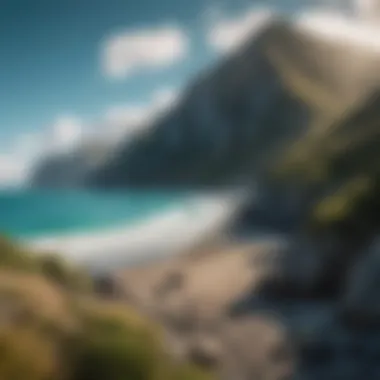

- Restoration Projects: Many organizations focus on replacing invasive species with native flora.
- Legal Protections: Areas like marine reserves protect underwater habitats from over-fishing and pollution.
- Community Initiatives: Local groups often engage in clean-up drives to protect beaches and wetlands.
Endangered Species
In New Zealand, certain species find themselves walking a precarious line. Birds like the kiwi and the takahē are symbols of the nation, yet they face significant threats, ranging from habitat loss to introduced predators. Indeed, the battle for survival has pushed some to the brink of extinction. When kids hear about the plight of the kakapo, a parrot that once numbered only about 50 individuals, it sparks a sense of urgency and responsibility.
A few important points regarding endangered species include:
- Species Protection Laws: The Department of Conservation has regulations aimed at protecting these precious creatures.
- Breeding Programs: Successful breeding programs have helped increase the numbers of species like the black robin.
- Public Awareness: Campaigns and programs teach the public about the importance of preserving these species and the roles they play within their ecosystems.
Community Involvement
No one can tackle conservation alone; it’s a community effort! In New Zealand, neighborhoods often join hands in fostering a love for nature. Kids, parents, and teachers go out into the wild, shovel in hand, ready to restore the environment. Engaging the community not only assists conservation but also builds a collective identity rooted in caring for the land.
Ways communities are getting involved include:
- Volunteer Days: Events where locals can come together to plant trees, clean parks, or set up birdhouses.
- Educational Programs: Schools incorporate environmental education, emphasizing the need for conservation.
- Social Media Campaigns: Platforms like Facebook and Reddit foster discussions and awareness about local conservation challenges.
The future of New Zealand’s wildlife hinges on the actions taken today. With community participation in conservation efforts, we can nurture the land and ensure that future generations can enjoy its beauty.
Activities for Nature Enthusiasts
Engaging in activities that celebrate and appreciate nature is more than just a pastime; it’s a way of connecting with the world around us. For families and children aged 5-12 years, participating in these activities can instill a deep respect for the environment and its beauty. New Zealand offers a treasure trove of options. They provide a thrilling adventure while also teaching valuable lessons about ecology and wildlife.
From hiking in lush national parks to observing unique animal species in their natural habitats, these activities highlight the importance of conserving New Zealand’s breathtaking landscapes and its rich biodiversity.
Exploring National Parks
New Zealand is home to many national parks, each boasting its own unique features. Queenstown, Fiordland, and Abel Tasman are just a few that showcase the country’s natural beauty.
- Adventure Awaits: In these parks, kids can embark on exciting hiking trails. The trails vary in difficulty, so there are paths suitable for everyone, from little ones just taking their first steps to seasoned young adventurers.
- Interact With Nature: Exploring national parks allows children to engage their curiosity. They can hunt for unusual plants or spot native birds like the Kiwi or the Takahe. It’s a hands-on way to learn about New Zealand’s ecosystems.
- Respect & Responsibility: While enjoying the parks, visitors also learn the importance of respecting wildlife and natural habitats. Taking care of the environment shouldn't just be a lesson learned in school—it should be practiced in the great outdoors.
Wildlife Watching
Wildlife watching can absolutely be a thrilling experience. New Zealand is renowned for its unique wildlife, some of which are found nowhere else on earth.
- Spotting Endangered Species: Children can participate in guided tours or simply keep an eye out for the rare Kakapo or the playful Hector's dolphin while boating near the coast. This kind of activity helps raise awareness about endangered animals and the efforts that go into protecting them.
- Exciting Encounters: Seeing animals in their natural habitat is often memorable. Whether it's hearing the unique call of the North Island Kaka in the trees or witnessing a seal colony at play, it's moments like these that build a lasting bond with nature.
- Skill Development: Wildlife watching encourages observation and patience. Kids learn to quiet their minds and observe the world around, which sharpens their concentration.
Nature Photography
Capturing the beauty of New Zealand through photography can be a fantastic outlet for creativity, especially for kids. It combines art with the natural world.
- Learning Perspective: Through their lenses, children can learn about composition, light, and texture. Understanding how to frame a shot encourages them to look at things differently, enhancing their appreciation of the environment.
- Sharing Experiences: Kids can create a photo journal of their adventures, further deepening their connection to nature. It’s also a wonderful way to share their experiences with friends and family after the trip.
- Conservation Through Art: Taking photographs of nature can drive home the message of conservation. When children express their love for nature artistically, they might feel more inclined to protect it.
Remember, every step taken on these paths through New Zealand contributes to a deeper connection with the environment. Respect and curiosity can go hand in hand to foster a sustainable future for generations to come.
End
As we draw the curtain on this journey through New Zealand's treasures, it becomes crystal clear how vital the topics we've explored are. Conservation, a mainstay of our discussion, proves not just important but essential. After all, New Zealand's natural environments are like a giant open book, filled with stories waiting to be told. Each mountain peak, coastal nook, and river bend is a chapter that contributes to the larger narrative of biodiversity. Without our efforts to protect these attributes, that narrative risks fading into silence.
The Importance of Conservation
Conservation refers to the practice of protecting nature's delicate balance. This is particularly crucial in New Zealand, home to numerous unique species and habitats. It's not merely about saving the rarest birds or plants; it extends to entire ecosystems. If one species disappears, it can have a ripple effect, impacting others. For example, the loss of the native kiwi bird—an icon of New Zealand—could hurt not just local habitats, but also the tourism that benefits the economy.
Key points to reflect on concerning conservation include:
- Awareness: Understanding what is at stake encourages people to take action.
- Engagement: Local communities are often the most effective guardians of their environments.
- Sustainable Practices: Civic choices like reducing waste and recycling foster a healthier planet.
Ultimately, conservation is a responsibility that we all share. It’s not just a lofty ideal; it’s a necessary practice to ensure that future generations can enjoy New Zealand’s wonders just like we do today.
Encouraging Future Generations
Raising awareness about environmental issues among young people is crucial for the future. By cultivating a sense of love and responsibility for nature at a young age, we set the groundwork for lasting care. Future generations will be the decision-makers in the coming years, so instilling these values early on can make all the difference.
To encourage this mindset, we can:
- Introduce Nature Exposure: Kids should spend time outdoors, knowing the local geographies. Visits to parks or nature reserves spark curiosity and respect for these spaces.
- Educational Activities: Schools can incorporate lessons about ecosystems and wildlife. Interactive sessions like trips to local conservation sites can be especially powerful.
- Lead by Example: Children observe their parents and caregivers. Demonstrating eco-friendly practices can inspire them to adopt similar habits.
In the end, the more we engage younger minds with the philosophy of conservation, the more likely they will become passionate stewards of the Earth. They are the ones who will carry the torch forward, shaping a greener future. Just as plants need sunlight to grow, societal values require nurturing and care.
"It takes a whole village to raise a child, and it takes a whole generation to raise a planet!"
By taking these steps today, we ensure that the vibrant ecological tapestry of New Zealand remains intact for those who come after.







